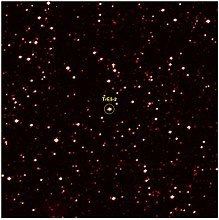Magnitude 11.41 Apparent magnitude (V) 11.41 | ||
 | ||
People also search for TrES-2b, Rho Draconis, Pi Draconis | ||
GSC 03549-02811 (sometimes referred to as TrES-2 A or TrES-2 parent star in reference to its exoplanet TrES-2), also known as Kepler-1) is a yellow main-sequence star similar to our Sun. This star is located approximately 718 light-years away in the constellation of Draco. The apparent magnitude of this star is 11.41, which means it is not visible to the naked eye but can be seen with a medium-sized amateur telescope on a clear dark night. The age of this star is about 5 billion years.
Contents
Planetary system
In 2006 the exoplanet TrES-2 was discovered by the TrES program using the transit method. It is also within the field of view of the previously operational Kepler Mission planet-hunter spacecraft. This system continues to be studied by other projects and the parameters are continuously improved. The planet orbits the primary star.
Though TrES-2b is currently the darkest known exoplanet, reflecting less than 1 percent of local sunlight, it does show a faint red glow. This is because its surface is a punishing 1,100°C, so hot that it actually glows red. It is assumed to be tidally locked to its parent star.
Binary star
In 2008 a study was undertaken of fourteen stars with exoplanets that were originally discovered using the transit method through relatively small telescopes. These systems were re-examined with the 2.2M reflector telescope at the Calar Alto Observatory in Spain. This star system, along with two others, was determined to be a previously unknown binary star system. The previously unknown secondary star is a dim magnitude 15 K-type star separated by about 232 AU from the primary, appearing offset from the primary by about one arc second in the images. This discovery resulted in a significant recalculation of parameters for both the planet and the primary star.
The Kepler Mission
In March 2009 NASA launched the Kepler Mission spacecraft. This spacecraft is a dedicated mission to discover extrasolar planets by the transit method from solar orbit. In April 2009 the project released the first light images from the spacecraft and TrES-2b was one of two objects highlighted in these images. Although TrES-2b is not the only known exoplanet in the field of view of this spacecraft it is the only one identified in the first-light images. This object is important for calibration and check-out.
